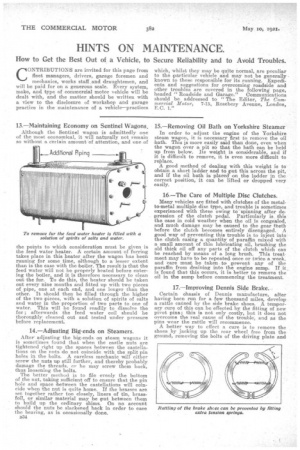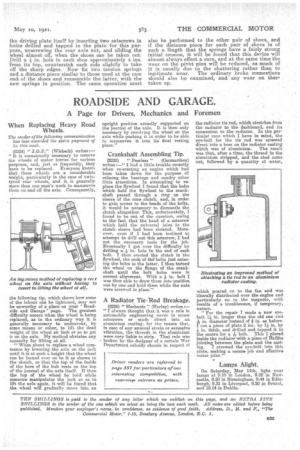HINTS ON MAINTENANCE.
Page 30

Page 31

If you've noticed an error in this article please click here to report it so we can fix it.
How to Get the Best Out of a Vehicle, to Secure Reliability and to Avoid Troubles.
CONTRIBUTIONS are invited for this page from fleet managers, drivers, garage foremen and mechanics, works staff and draughtsmen, and will be paid for on a generous scale. Every system, make, and type of commercial motor vehicle will be dealt with, and the matter, should be written with a view to the disclosure of workshop and garage practice in the maintenance of a vehicle—practices which, whilst they may be quite normal, are peculiar to the particular vehicle and may not be generally known to those responsible for its running. Expedients and suggestions for overcoming roadside and other troubles are covered in the following page, headed " Roadside and Garage!' Communications should be addressed to "The Editor, The Commercial Motor, 7-15, Rosebery Avenue, London, E.O. 1."
13.—Maintaining Economy on Sentinel Wagons.
Although the Sentinel wagon is admittedly one of the most economical, it will naturally not remain so without a certain amount of attention, and one of the points to which consideration must be given is the feed water heater. A certain amount of furring takes place in this heater after the wagon has been running for some time, although to a lesser extent than is the ease with the boiler. The result is that the feed water will not be properly heated before entering the boiler, and it is therefore necessary to clean out the fur. To do this, the heater should be taken out every nine months and fitted up with two pieces of pipe, one at each end, and one longer than the other. It should then be filled through the higher of the two pieces, with a solution of spirits of salts and water in the proportion of -two parts to one of water. This will be found readily to dissolve the fur ; afterwards the feed water coil should be thoroughly cleaned out and tested under pressure before replacement.
14.—Adjusting Big-ends on Steamers.
After adjusting the big-ends on steam wagons it is sometimes found that when the castle nuts are tightened right up the spaces between the castellations on the nuts do not coincide with the split pin holes in the bolts. A careless mechanic will either screw the nuts up still further, and thereby probably damage the threads. or he may screw them back, thus loosening the bolts. The better method is to file evenly the bottom of the nut, taking sufficient off to ensure that the pin hole and space between the castella.tions will coincide when the nut is quite home. If the brasses are set together rather too closely, liners of tin, brass foil, or similar material may be put between them to build up the ordinary shims. On no account should the nuts be slackened back in order to ease the bearing, as is occasionally done. 1334 15.—Removing Oil Bath on Yorkshire Steamer In order to adjust the engine of the Yorkshire steam wagon, it is necessary first to remove the oil bath. This is more easily said than done, even when the wagon over a pit so that the bath can be held up from below. Its weight is considerable, and if it is difficult to remove, it is even more difficult to replace. A good method of dealing with this weight is to obtain a short ladder and to put this across the pit, and if the oil bath is placed on the ladder in the correct position, it can be lifted or dropped very easily.
16.—The Care of Multiple Disc Clutches.
Many vehicles are fitted with clutches of the metalto-metal multiple disc type, and trouble is sometimes experienced with these owing to spinning after depression of the clutch pedal. Particularly is this the case in cold weather when the oil is congealed, and much damage may be caused to the gear teeth before the clutch becomes entirely disengaged. A good way of preventing this trouble is to inject into the clutch casing a quantity of paraffin mixed with a small amount of thin lubricating oil, brushing the old thick oil off any parts of the dutch which can be reached by means of a. long brush, This treat merit may have to be repeated once or twice a week, and care must be taken to prevent any of the paraffin from draining into the engine sump. If it. is found that this occurs, it is better to remove the oil in the sump before commencing the treatment.
17.—Improving Dennis Side Brake., Certain ohassis of Dennis manufacture, after having been run for a few thousand miles, develop a rattle caused by the side brake shoes. A temporary cure of this can be effected by the fitting of new pivot pins; this is not only costly, but it does not overcome the real cause of the trouble, and as the pins wear the rattle will recommence. A better way to effect a cure is to remove the shoes by jacking up the rear wheel free from the ground, removing the bolts of the driving plate and the driving plate itself by inserting two setscrews in holes drilled and tapped in the plate for this purpose, unscrewing the rear axle nut, and sliding the wheel almost off, when the shoes can be taken out. Drill a 1 in. hole in each shoe approximately 4 ins. from its top, countersink each side slightly to take off the sharp edges. Now fix two tension springs and a distance piece similar to those used at the cam end of the shoes and reassemble the latter, with the new springs in position. The same operation must
also be performed to the other pair of shoes, and i
if the distance piece for each pair of shoes s of such a length that the springs have a fairly strong initial tension, it will be found that this device will almost always effect a cure, and at the same time the wear on the pivot pins will be reduced, as much of it is usually due to the chattering rather than to legitimate wear. The ordinary brake connections should also be examined, and any wear on then, taken up.
































